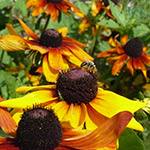Quick facts
- These nine flowers attracted the most pollinators in a study of more than 30 annual flower varieties.
- Annual flowers are not hardy in Minnesota and must be replanted each year.
- Annual flowers provide color and interest in a landscape and are some of the easiest plants to grow.
- Pollinators are attracted to these flowers because of their bright colors and ease of finding nectar and pollen.
Why plant annual flowers?
Annual flowers have been a long-time favorite plant for gardens of all kinds. They provide instant color and interest and are relatively easy to grow.
The following nine annual flowers were found to be the most attractive to pollinators in a 4-year study (2015-2018) of more than 30 varieties. If you want to attract pollinators think about adding these flowers into your garden, containers and raised beds.
Best varieties of annual flowers to attract pollinators
Music Box Mix sunflower (Helianthus annuus ‘Music Box Mix’)
- Dwarf sunflower; performs well in containers and garden beds.
- Multi-branching and continuous 4-5 inch blooms until frost.
- Flower color varies from creamy to bright yellow to deep gold and red bicolor.
- Very popular with all pollinators, especially honey and bumblebees.
- Size: 4-5 feet high, 2-3 feet wide.
- Direct seed in full sun.
Lemon Queen sunflower (Helianthus annuus ‘Lemon Queen’)
- Large sunflower that will tower overhead.
- An heirloom variety that is very popular with bees of all kinds.
- Bright, clear yellow 10-inch flowers.
- Leave the spent flower heads hanging for fall and winter birdseed.
- Plants can grow to 7-8 feet tall, 2 feet wide.
- Full sun.
- Direct seed. Will re-seed.
Summer Pink Jewel Salvia (Salvia coccinea ‘Summer Jewel™ Pink’)
- Graceful pink and white blooms are favorites of bumblebees.
- Irregular sage-like flowers with protruding anthers, making it easy for bees to access pollen and nectar.
- Grows to 18-22 inches high, 12-18 inches wide.
- Full sun. Start seeds in well-drained media.
- Remove spent blooms for continual flowering.
- Will re-seed.
Purple Fairy Tale Salvia (Salvia verticilliata ‘Purple Fairy Tale’)
- Lavender to deep purple flowers encircles each stem.
- Very popular with honey and bumblebees.
- Grows 12-15 inches high, 12 inches wide. Full sun.
- Direct sow or start seeds indoors in well-drained soil.
- Remove spent blooms to promote continual flowering.
- Will re-seed.
Orange Fudge Black-eyed Susan (Rudbeckia hirta ‘Orange Fudge’)
- Insects love this delightful and colorful plant.
- Expect many blossoms on a single plant and continuous bloom.
- Grows to 24 inches high, 18 inches wide in full sun.
- Direct sow or start seeds indoors.
- Slow to germinate, but worth the wait.
- Will re-seed.
Prairie Sun Black-eyed Susan (Rudbeckia hirta ‘Prairie Sun’)
- Deep gold and yellow flowers with consistent coloring and form.
- Blooms all summer long.
- Large 3-4 inch flowers and an upright form make this a great plant to mix with other flowers and edibles.
- Grows to 24 inches high and 12-18 inches wide in full sun.
- Start indoors or direct sow.
- Will re-seed.
Showstar Butter Daisy (Melampodium paludosum ‘Showstar®’)
- A prolific bloomer.
- Small golden flowers.
- Grows to 24 inches high and 24 inches wide.
- The rounded form makes this plant great for masses, borders, backdrops, and all-around excellent summer-long interest.
- Full sun.
- Start seeds indoors.
Dakota Gold Sneezeweed (Helenium amarum ‘Dakota Gold)
- The smallest of our top pollinator annuals, but a favorite of native bees and syrphid flies.
- Small bright yellow flowers and delicate foliage.
- Grows to 12 inches high and 8-12 inches wide.
- A perfect border plant thanks to its rounded form.
- Direct sun.
- Start seeds indoors in well-drained soil.
Envy Zinnia (Zinnia elegans ‘Envy’)
- What is a garden without zinnias? Bees big and small are all over this zinnia whose flowers range from pale yellow-green to lime green.
- Flower form is wide and open, making it easy for pollinators to do business with the flower.
- Flowers are 2-3 inches wide.
- Plants grow to 24 inches high, 18 inches wide.
Funding for Flowers for Pollinators was provided through a gift from the Horst Rechelbacher Foundation.
Reviewed in 2021










